Are you thinking about visiting Death Valley National Park but aren’t sure what to expect when you want to go? Then this guide is for you.
I’m James Ian and I’m a national park expert. By the end of this guide, you’ll know exactly what to expect every month of the year so you can make an informed decision about when to go.
‼️ If you just want a quick snapshot about my thoughts on the best time to visit Death Valley National Park, check out my Best Time to Go to Death Valley National Park guide. ‼️
Subscribe to daily national parks planning tips, travel inspiration and trip ideas and get instant access to the free PDF of this guide to
Visiting Death Valley National Park Throughout The Year
No time right now to learn what to expect throughout the year when visiting Death Valley National Park? Pin It and save it for later:

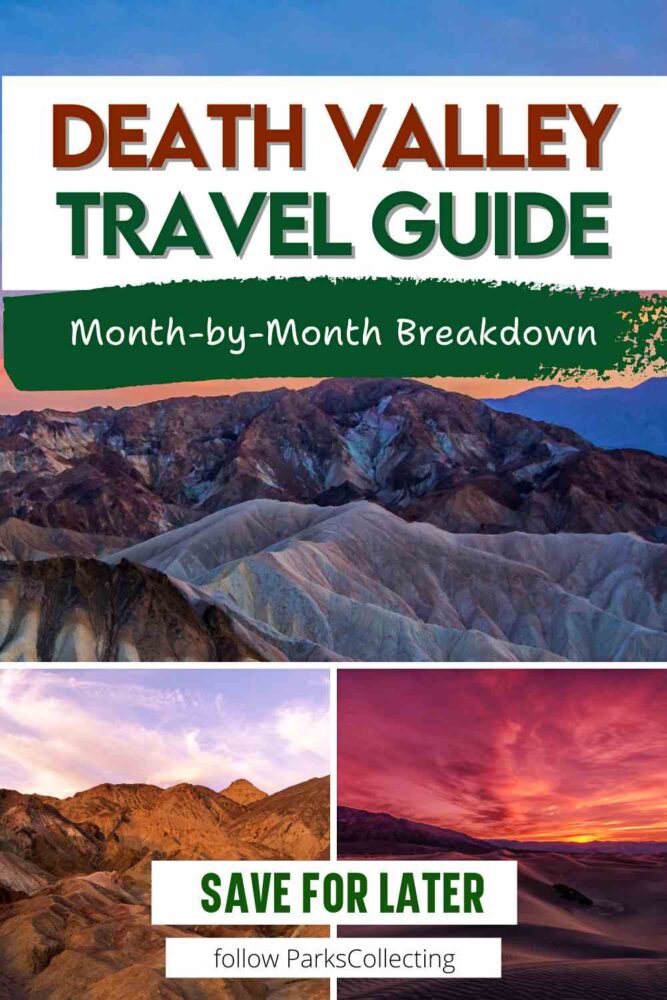
🛏️TOP HOTEL PICK: Check availability now
🚘FIND THE CHEAPEST CAR RENTAL: Search Discover Cars for the best deals
✈️FIND THE CHEAPEST FLIGHTS: Search Skyscanner for the best deals
🧳GET TRAVEL INSURANCE: Get insured with Travelex before you go
📱TAKE AN AUDIO TOUR: Buy an audio tour now
Table of Contents
Death Valley National Park in Spring (March – April)
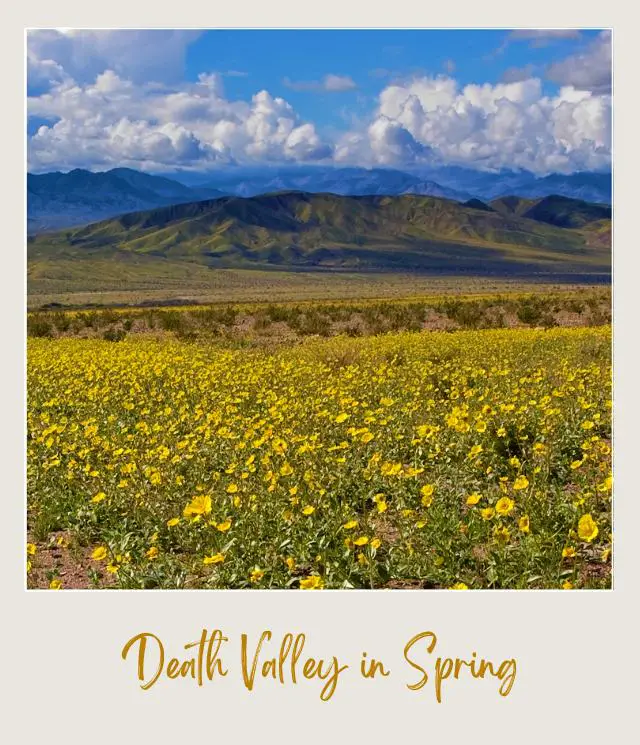
During the short spring season, you can expect the Death Valley average temperature to be pleasantly warm, hovering between the 60s and 90s (Fahrenheit).
Visiting Death Valley in March
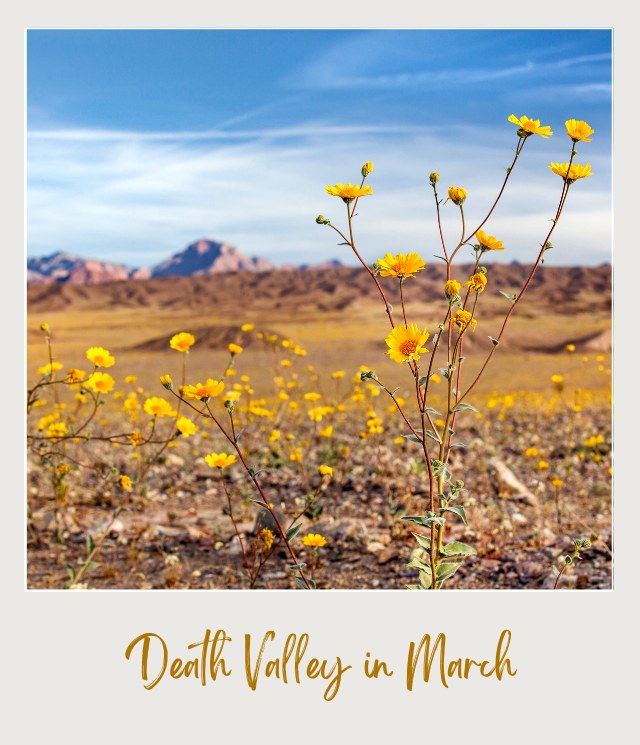
Death Valley in the spring is when this part of eastern California and Nevada comes alive with an abundance of wildflowers. The Death Valley National Park weather also really starts to warm up at this time of year, as the days grow longer.
Though it may seem early in spring, the mild Death Valley weather in March means that many wildflowers are already in full bloom by then. In fact, the blooming season begins in the middle of February here, lasting until June or July.
So, if you’re wondering “When is the best time to visit Death Valley for flowers?”, then March has to be a contender. In general, the blooms are at their peak during March and April. Death Valley National Park in March is usually awash with beautiful wildflowers.
How about the Death Valley National Park weather in March – what can you expect? Average highs in March are around 82°F (28°C). Lows are about 55°F (13°C). You can also expect about one day of rainfall during this month.
In summary, the climate in Death Valley during March is pleasantly warm, without being too hot. This is also one of the best months for wildflowers. March is therefore an ideal time to visit Death Valley – but do be aware of the spring break busy season during the second half of the month!
Pros
- Warm weather
- Lots of wildflowers
- Lower priced accommodations
Cons
- Spring break season can mean late March is busy
Visiting Death Valley in April
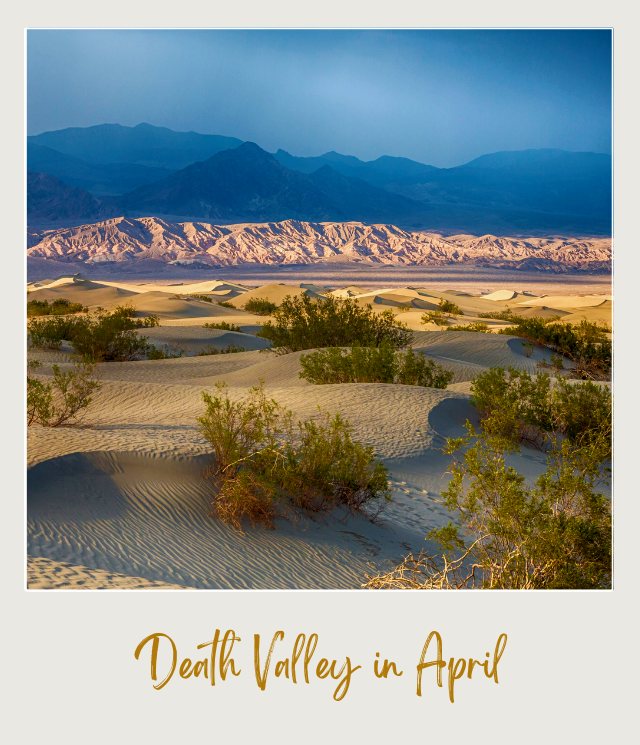
If you’re not daunted by the prospect of spring break crowds, then the Death Valley weather in April is still milder than it will be until at least October. Death Valley National Park in April is also still packed with wildflowers, and this is one of the best months to see these.
The Death Valley National Park weather in April is a little warmer than in March, and you can expect no days of rain on average during the month. Average high temperatures in April are about 90°F (32°C). Lows are typically about 63°F (17°C).
Again, whether April is a good time to visit Death Valley depends on your attitude to spring break. The NPS advises booking accommodations months ahead for this time of year, as all types of lodging are reserved well in advance and thus fill up quickly.
Pros
- One of the best months for wildflowers
- Milder weather than in May through September
Cons
- Accommodations book up months in advance
- The park is busy throughout April due to spring break
Death Valley – Summer (May – September)
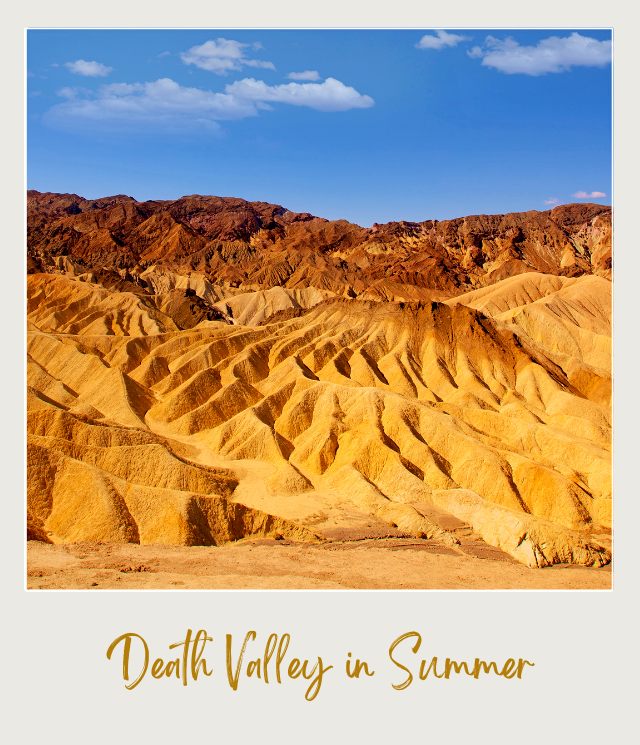
Summer is long and hot! In the main, the extreme Death Valley summer weather means that visitors can only comfortably tour the park by staying in air-conditioned accommodation and remaining inside the car.
Visiting Death Valley in May
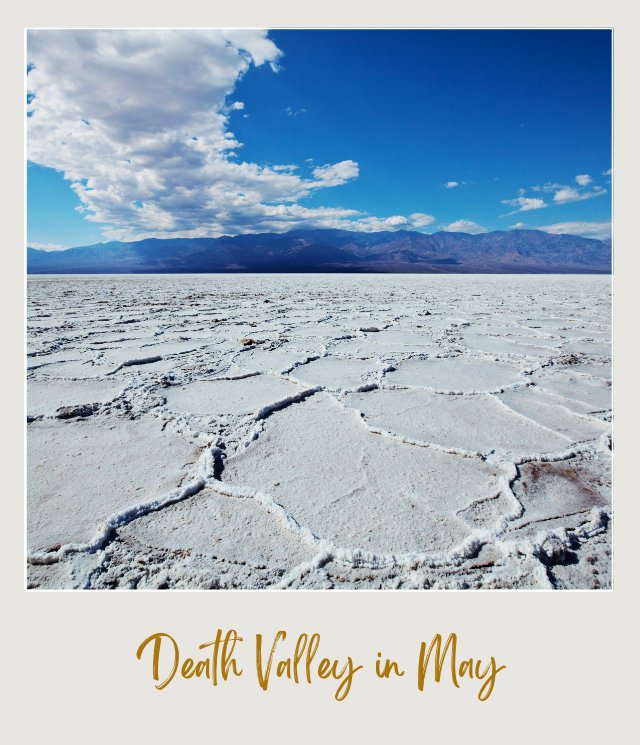
Death Valley National Park in summer is, as you might expect, a dangerously hot place to be. However, relatively speaking, May isn’t too bad.
The Death Valley weather in May is comparable to late September or early October, once the searing summer heat has dissipated somewhat. Average highs are around 100°F (38°C), with lows of about 72°F (22°C). So, while the weather is hotting up, it’s more comfortable than later in the summer.
According to the NPS, the weather at Death Valley National Park in May is too much for a lot of visitors unaccustomed to high temperatures, yet the park remains busy. The truth is that the weather people can bear varies very much and can be down to what each individual is used to.
You can still see wildflowers in the park during May, but they will have passed their March and April peak by this point. Many visitors to Death Valley drive around from May onwards, and the campgrounds can be stiflingly hot even by this time of the year.
Pros
- You can still see wildflowers
- It’s not as hot as June, July and August
Cons
- Visitors unused to heat may struggle
- Many find it too hot to hike or camp out
Visiting Death Valley in June
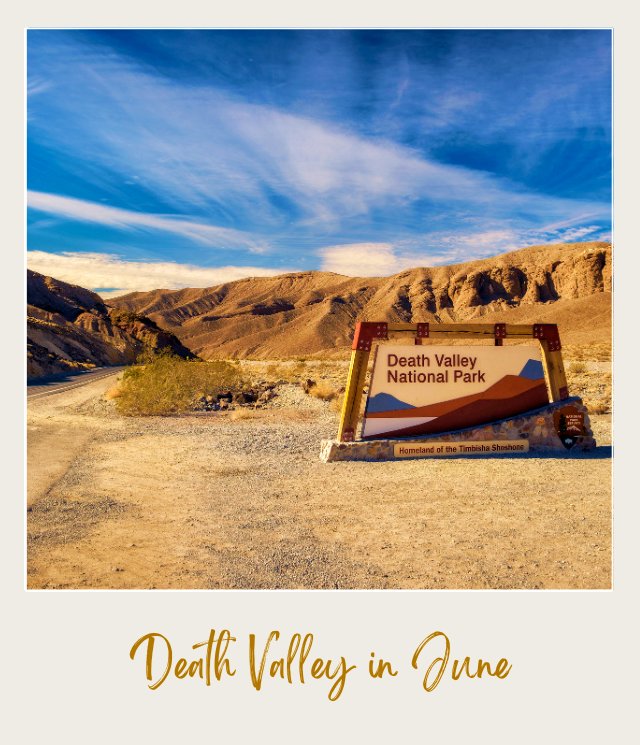
The Death Valley temperature in June is really starting to increase. Though the temperature in June is lower than in the following months of July and August, you can still expect highs of around 111°F (44°C) and lows of about 82°F (28°C). This makes Death Valley National Park in June too hot for most people.
You might still see some wildflowers in June, but these are by now way past their spring peak. The fact that it’s often too hot to get out of your air conditioned car by June limits what you can see and do. Temperatures are also too high for many to comfortably sleep under canvas during June.
Pros
- Some wildflowers may still be in bloom
- Temperatures have not quite reached their peak
Cons
- It’s too hot to camp or hike for most people
- Having to stay in the car can restrict what you may see and do
Visiting Death Valley in July
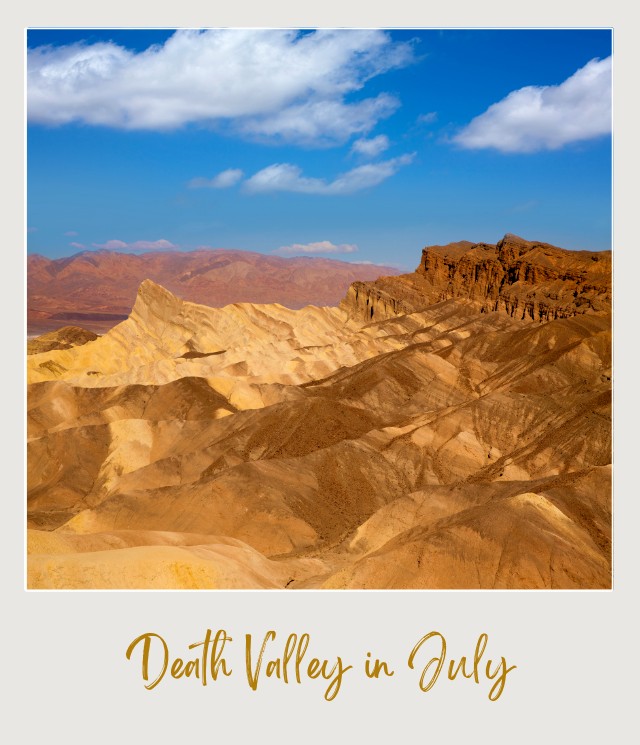
As you might expect by now, the Death Valley temperature in July makes the park an unbearable place to be for many people. Death Valley National Park in July is as hot as it gets, with averages slightly higher than in August. So don’t expect to camp out comfortably or want to leave your air-conditioned vehicle when visiting during the summer peak!
The Death Valley weather in July means average high temperatures of 117°F (47°C) and average lows of 88°F (31°C). When exploring a national park is all about spending time outdoors, this makes July a bad time to visit the park. Unless, perhaps, you’re very used to coping with such hot and dry conditions. Or just want bragging rights and a photo next to the outside thermometer showing just how hot it is.
If you’ll be staying in air-conditioned accommodations and are happy to tour the park by car, then July may be an okay time to visit Death Valley. Otherwise, it’s wise to steer well clear, saving your visit for when the weather is cooler.
The NPA advises visitors who do head to the park in July to stay close to their vehicle, and on paved roads at all times. This should give you some indication regarding how extreme the summer weather can be here!
Pros
- It’s possible to explore by car
- You can stay in air conditioned accommodations
- Bragging rights as to how it was when you were there
Cons
- Remaining on paved roads and near your car is advised
- It’s far too hot for hiking the trails or camping
Visiting Death Valley in August
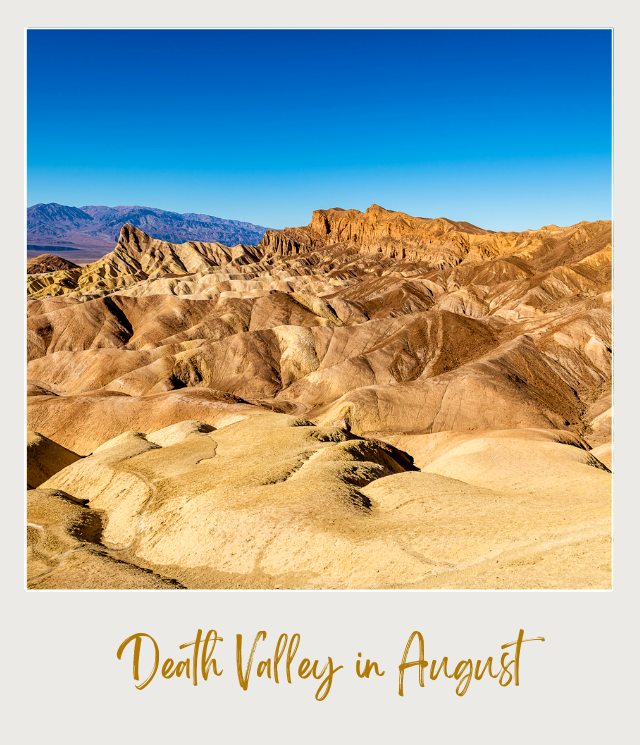
If you’ve already read the above advice regarding July, then you can expect more of the same when it comes to the Death Valley August weather. Temperatures do start to drop from here on for the rest of the year, but only by a very minimal amount so far.
During August, temperatures are about one or two degrees, on average, cooler than in July. So don’t really expect any discernible difference! Average high temperatures in Death Valley in August are around 115°F (46°C), with average lows of about 86°F (30°C).
Again, you need to remain on paved roads and stay close to your car. It’s far too hot to hike or camp under canvas in August, so the only option is air-conditioned accommodation and touring by vehicle rather than on foot.
Pros
- You can tour the park by vehicle
- Air-conditioned accommodation will keep your cool
Cons
- To stay safe, you should stay close to your car and on paved roads
- Camping and hiking are unrealistic due to the heat
Visiting Death Valley in September

If you’ve been put off by the descriptions of the stifling summer heat, then you might well be wondering what the Death Valley September weather is like. In short, though the is a little more bearable than during the preceding months of June, July and August, it’s still hotter on average than in May.
As compared to the start of summer in May, the Death Valley weather in September is several degrees hotter. Average high September temperatures in Death Valley are about 106°F (41°C), with average low temperatures of around 75°F (24°C).
The weather in Death Valley in September again means that most people can only realistically, and comfortably, stay in air-conditioned accommodation rather than camping. Instead of taking to the trails to discover the park, the Death Valley September temperature forces most visitors to stay in – and always close to – an air-conditioned vehicle too.
If visiting Death Valley National Park in September seemed like a good option due to schools being back and the park being quieter, do think carefully about how such extreme desert weather will affect your plans. I’ve visited mid-September, and it was possible to do short hikes in the morning and late afternoon, but the middle of the days was very unpleasant to be outside.
Drink lots of water if you do head out!
Pros
- It’s ever so slightly cooler than in June, July and August
- You can stick to air-conditioned accommodation and tour by car
Cons
- The weather is generally still too hot for camping and most hiking
- You’ll be limited to the main roads and their points of interest
Death Valley National Park in Fall (October – November)
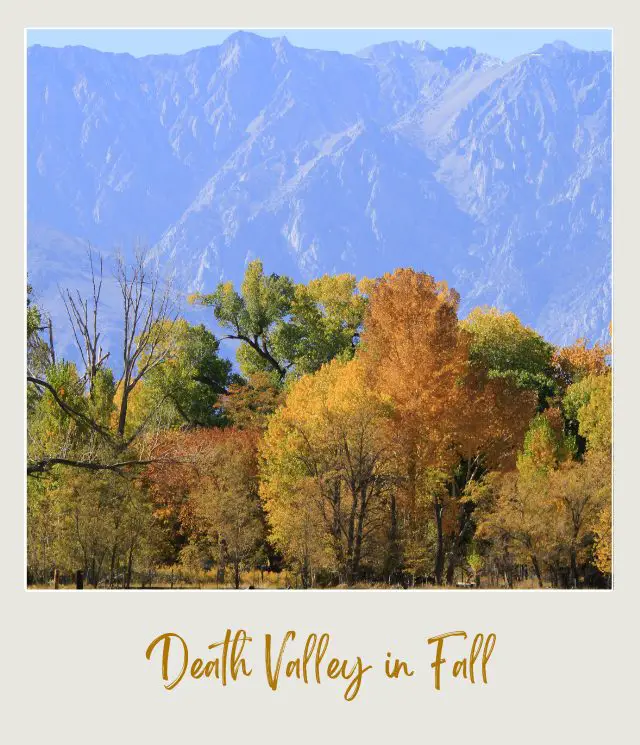
Fall comes late to Death Valley. During fall, temperatures begin to cool down, though they can vary, and apart from a couple of busy periods this is a good time to visit the park.
Visiting Death Valley in October

So, what does the Death Valley weather from October onwards mean for your prospects of visiting the park? Is the temperature in Death Valley in October more bearable, or is it best to wait until November or December to visit?
The Death Valley weather in October is somewhere between that of April and May. Temperatures, on average, range between highs of 93°F (34°C) and lows of 63°F (17°C). Fall doesn’t really arrive until late October, however, so expect it to be hotter – and more like summer – earlier in the month.
The weather in Death Valley in October means you can still expect no rainy days during the month, on average. Camping season and park ranger programs start this month. During fall, the park is rarely crowded.
Death Valley National Park in October is quieter than November, due to Thanksgiving and the Death Valley ‘49ers encampment that occurs then.
Pros
- The Death Valley temperature in October is more manageable than summer highs
- By later in the month, the Death Valley October weather has cooled down more
- Hiking and camping are a reality in fall, from October onwards
Cons
- At the start of the month, the Death Valley National Park weather in October can still be very hot
- Temperatures can vary more at this time of year
Visiting Death Valley in November

The average Death Valley weather in November makes this the fourth coldest month of the year here. Death Valley National Park in November is in general a good place to be, though it can be busy during two periods in particular.
Thanksgiving is the obvious one, but there’s another local event that makes the most of the cooler Death Valley National Park weather in November. This is the ‘49ers encampment which takes place annually. Usually this occurs in early November. So the park can be crowded then, and of course around the fourth Thursday of the month.
The Death Valley temperature in November ranges between highs of about 77°F (25°C) and lows of around 48°F (9°C). This makes hiking and camping a far more attractive proposition, and in fact the camping and ranger program season is in full swing by now.
Pros
- Cooler temperatures make hiking much more pleasant
- The camping season and ranger programs are fully operational
- You can explore the park fully without being impeded by the weather
Cons
- The ‘49ers encampment can make early November busy
- The park can also get crowded around Thanksgiving
Key Events in November:
✳️ Death Valley ‘49ers encampment | Early November for 3 nights
Death Valley – Winter (December – February)
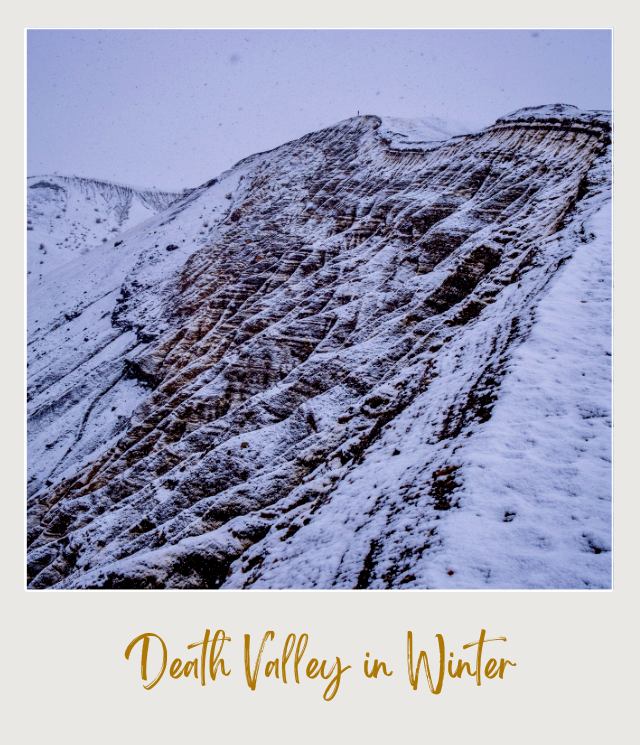
Death Valley in winter is one of the most pleasant places to be, as it’s warm in comparison to many other places in the US – and indeed on earth.
Visiting Death Valley in December
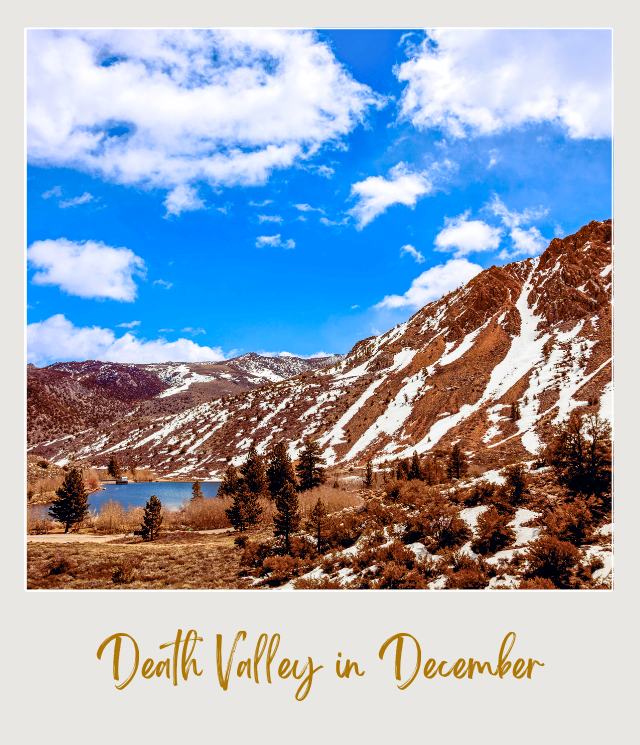
The Death Valley National Park winter begins in December. As compared to other parks across the US, Death Valley in the winter isn’t as cold. You can also expect no days of rain during December, as in the preceding months.
The average Death Valley temperature in December involves highs of about 66°F (19°C) and lows of around 39°F (4°C). So, it can be pleasantly mild, or even pretty chilly at times. Extreme lows aren’t common in Death Valley National Park in winter, though.
So, what’s it like visiting Death Valley National Park in December? Together with January, this is one of the coldest months in the usually balmy states of California and Nevada.
Visiting Death Valley in December is preferable for many people, however, as you can avoid the extreme summer heat. This is one of the warmest places to be in the US at this time of year. Though you shouldn’t expect snow as part of the Death Valley weather in December, you may see some on the peaks surrounding the park.
Nights get chilly and you should plan for that, especially if you’re camping. The Death Valley temperature in winter is generally good for hiking, though you may need a light jacket and a pair of pants rather than summer clothing.
Pros
- Cooler temperatures make hiking pleasant
- Among the warmest places in the US during winter
- The park tends to be quiet between Thanksgiving and Christmas
Cons
- It can be busy around Christmas and New Year
- The weather can be chilly at night when camping
Visiting Death Valley in January
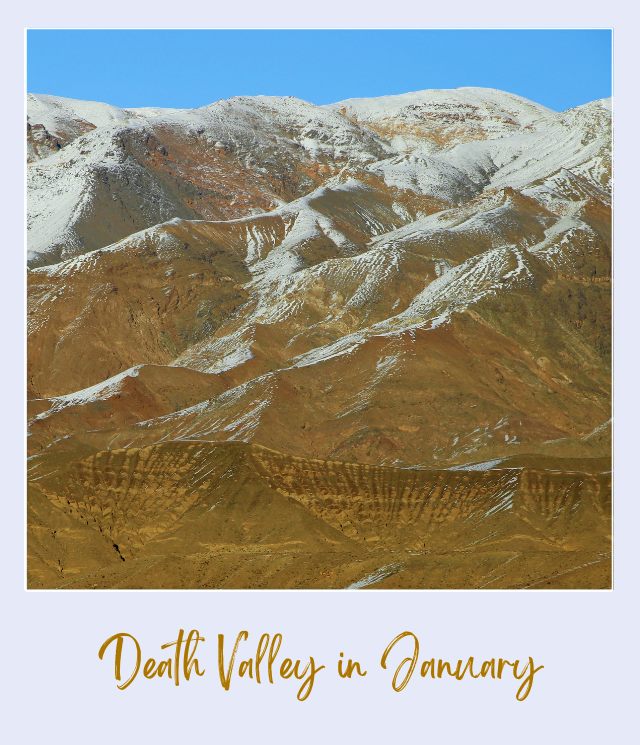
If you’re thinking about visiting Death Valley National Park in January, then you can expect the same temperatures, on average, as in December. This means there are highs of around 66°F (19°C) throughout the month, with lows of around 39°F (4°C).
The Death Valley National Park weather in January may not seem typical of a hot, subtropical desert climate, but it’s still warmer than many other places in winter. Hiking and camping are comfortable, as long as you bring warm enough bedding for chilly nights, long pants and a light jacket.
January can be quiet in Death Valley, during the post-Christmas period. This also means you might pay less for accommodations then. In January, Martin Luther King Day weekend can be busy, though.
Pros
- Very cold weather is rare, especially during the day
- Mild temperatures are ideal for winter hiking
- This is one of the quietest times of the year
Cons
- The park can be crowded on Martin Luther King Day weekend
- You’ll need extra bedding and clothing for colder weather at night, especially if camping
Visiting Death Valley in February
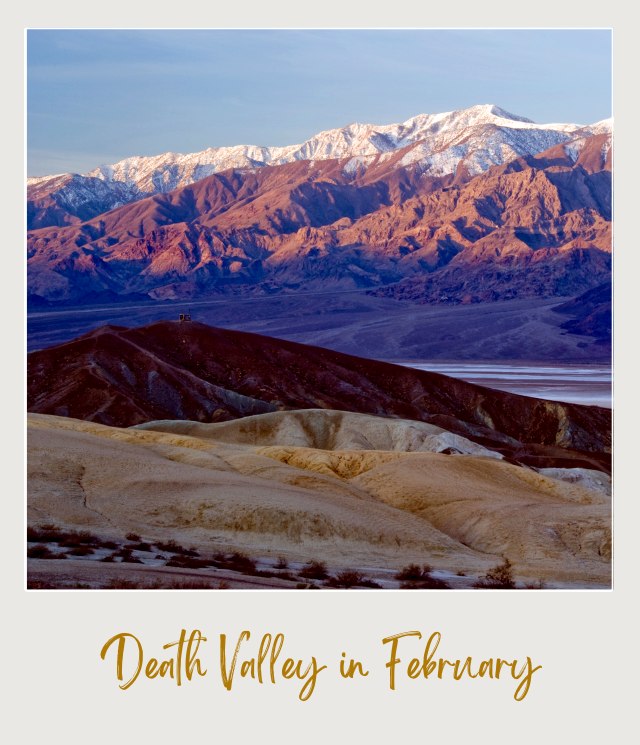
The Death Valley weather February is when the park slowly starts to warm up after winter. Temperatures are a little higher than in December and January, though on average it’s slightly colder than November. This is the pre-spring period in this part of the world, as by March it should be properly warm.
Visit Death Valley National Park in February and you can enjoy fewer crowds than in spring, though this may not be true during Presidents’ Day weekend. Camping and hiking are pleasant at this time, too.
During February, expect highs of around 73°F (23°C) throughout the month, with lows of around 46°F (8°C). You might see some wildflowers in bloom, especially before the end of the month, before their spring peak in March and April.
Pros
- More peaceful pre-spring period
- Temperatures are pleasant for hiking and camping
- You may see wildflowers by the end of the month
Cons
- Presidents’ Day weekend can be busy
- It’s not quite as nice a time to visit as in spring
Travel Insurance for Death Valley National Park
No matter when you decide to visit Death Valley, you should definitely get travel insurance. This can protect you not only against medical and emergency repatriation, but can also cover things like trip cancellation, loss and/ or theft of property, etc.
➡️A great insurance option is Travelex. It has coverage for all you’ll need. You can compare Travel Insurance plans here or get a quote right now:
Enjoy Death Valley National Park!
Additional Planning Resources for Death Valley National Park
⭐ Planning A Trip to Death Valley National Park: 7 Mistakes to Avoid
⭐ Best Hikes in Death Valley National Park
⭐ 10 Fun Facts About Death Valley National Park
⭐ The Closest Airport to Death Valley National Park
⭐ All The Airports Near Death Valley National Park
⭐ How to Get to Death Valley National Park
⭐ Best Time To Visit Death Valley National Park
⭐ 10 Tips for Visiting Death Valley National Park
What do you think is the best month to visit Death Valley National Park? Join my private Facebook group National Parks Collectors and comment and let me know (you can also pick up extra planning tips, share your photos and stories with other national park lovers and more).
Subscribe to daily national parks planning tips, travel inspiration and trip ideas and get instant access to the free PDF of this guide to
Visiting Death Valley National Park Throughout The Year
If you liked this article about visiting Death Valley National Park, Pin It to your Death Valley National Park board!


💡 Are you just starting to think about taking a national parks trip? Get Inspiration
‼️ Are you looking for helpful tips for visiting US national parks? Read articles that share useful tips on a range of national-park related issues
💻 Are you starting to plan a trip to Death Valley National Park? Read my Guide to Death Valley National Park
💲 Are you ready to book your trip? Use these Planning and Booking Resources
📖 Do you want to read a book about US national parks? Check out my Recommended Reading Lists
About the Author
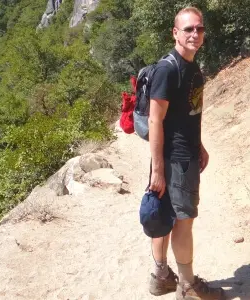
James Ian is a national park, camping and hiking expert.
He has dedicated his life to travel, visiting more than 80 countries, all 7 continents and most of the national parks in the United States. With over 35 years experience in the travel industry, James has worked on cruise ships, at resorts and hotels, and as a travel planner who’s helped hundreds of people plan successful trips to US national parks.
Based on his experience visiting our national parks multiple times, in-depth research and expertise as a travel planner, James has published detailed itineraries for many of the major national parks in the US. These itineraries, as well as in-depth park guides, and other resources will help you have your own incredible trip to US national parks without stress and hassle.
As a national park expert, James has contributed to many publications, including USA Today, Newsweek, Time Business News, Savoteur, Best Trip, and Wired.
I’m a member of the Amazon Services LLC Associates Program. As an Amazon Associate I earn from qualifying purchases.
